I first met Eric Drobile while working on an animation project, but we were casually introduced at a dear friend’s Halloween party. With a genuine smile, bright eyes and almost pearlescent skin, this fine artist comes across as almost cherubic at first meeting. But Eric has a rare combination of gifts. Indeed, I have yet to find another artist who not only takes my breath away with his sensitive, soul-capturing portraits but also leaves me cringing and giggling over his basely wicked webcomics. The angelic face hides devilry, no doubt about it. So it is my great pleasure to sit down with such a talented man and see what cerebral road map, what combination of brain chemistry, creates such a potent paradox.
.
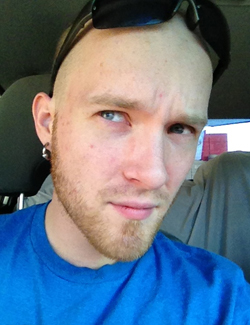
ERIC DROBILE — ANIMATOR, PAINTER AND COMIC ARTIST
.
KARA: Hi Eric! I am so glad you could meet with my readers today.
.
ERIC DROBILE: Thanks for having me, Kara! Can I call you Kara? I’m a huge fan of your interviews so this is rad on all accounts.
.
KARA: Absolutely, and thank you! I’ve been looking forward to chatting with you, too. Right now you are juggling a lot of projects–your work in animation, your painting, and your comics website to name a few. Are you compelled by impulse when choosing which to tackle daily, or do you keep a schedule?
.
ERIC DROBILE: Generally these days I keep the animation stuff at the studio. I used to do a lot of traditional flash animation on my own time, but 8+ hours of animating a day for work is pretty tiring. Being able to draw or paint digitally at home is a huge release for me. I don’t like planning or projects that last more than two weeks (I won’t finish them), so the comic format works great. If it’s a project I really care about, and it usually is, I’ll come home and start working on that and put off everything else (chores, showering, eating, etc.). This is a great way to lose friends and smell bad but the creative output can be worth it. When I can, I’ll throw a digital painting of my own in the mix (usually of subject matters that are very cathartic to me like portraits of my girlfriend) to experiment with painting techniques and explore styles that are opposite of the comic.
.
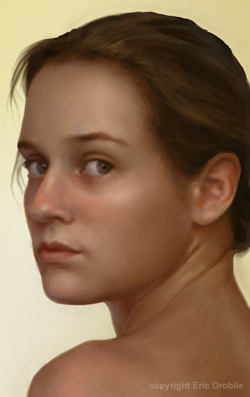
.
KARA: Besides your edgy comics you are also an accomplished animator and fine artist. Your portraits are truly breathtaking. How long have you been painting?
.
ERIC DROBILE: I think I have been digitally painting for about 10-12 years now…since the high school days. But even younger than that I was constantly drawing and “animating” things with a mouse in early windows or crude DOS programs. I was drawing things on paper, apparently, since I could pick up a pencil and never really stopped. I have only done a small handful of non-digital paintings in my lifetime…I do not have the patience for it.
.
KARA: I notice a warmth in your lighting that reminds me of Rembrandt’s work. Who were your biggest sources of inspiration?
.
ERIC DROBILE: I think most of my inspiration has always been contemporary, coming mostly from film, television and video games. I grew an appreciation for the old masters through my art education at Ringling College, but have always turned to the internet for inspiration when I needed it. I can’t think of one “painter” I have admired and studied…however, from the animation and gaming world I drew dozens of heroes. The Oddworld game series fueled my imagination as a teenager and taught me to love weird creatures with dark, industrial, textural environments. Ren and Stimpy is a show I worship to this day — it taught me that being really demented, weird and gross can be totally hilarious if you really push it. Beavis and Butthead helped me find humor in stupid shit. The Maxx was a short lived tv series (and comic book, although I was not exposed to it much) and taught me a lot about drama, surreal atmosphere and cool action. Earthworm Jim, Monkey Island and Day of the Tentacle were just a few of the video games with art direction that I worshiped, and I think you can see some influence of them in my art today. Lately, I have been studying master animators like Glen Keane to really try to get my drawing skills in check. His drawing abilities are just unbelievable.
.
KARA: Was there a teacher who inspired you or whose lessons really stuck with you on your artistic journey?
.
ERIC DROBILE: I’ll say I had probably the best support any young artist could ever have from my parents and family. I remember being told by my family at a very young age that I’d be an animator at a major studio some day. At the time I remember that being an impossible goal and thinking my family should get their heads out of the clouds. But that planted a seed that is now a reality and I wouldn’t be able to thank them enough for it if I tried. I’ve had some great teachers along the way, but I think I always have and always will look to the most creative of my peers for strength, motivation and inspiration. I try not to show it, but I am most thankful to these people because without them I am nothing.
.
KARA: Does life drawing come easily to you? What have you found are your steps or techniques which best help you to capture the ‘ look’ or ‘soul’ of your subject?
.
ERIC DROBILE: I think at one point life drawing was easy for me — and that is because I spent hours a day, for years, drawing in a sketchbook. This was college. Now I do almost no life drawing (because it is all on a computer) so I’m awful at it. I need tons and tons of reference to draw something realistically. Cartoon drawing is my focus these days. The best advice for any kind of drawing is to do it every day, but not only that, experiment every day. Spend some time doing what you are comfortable with, and then force yourself to see things differently, to make your pencil marks differently, to hold your hand, arm and shoulder differently. Do experiment with your subjects, but also never lose interest in what it is you are drawing. The more you enjoy drawing, the easier drawing every day for years becomes. Kind of an obvious statement, but I meet young artists who spend far too much of their time being frustrated at their art, and contemplating how not to fail… You can better believe the first 10 years of your artistic life is going to be mostly fail, that’s part of the journey. For me, I still hate a lot of my work, but I push through it and get something pretty cool every now and then.
.
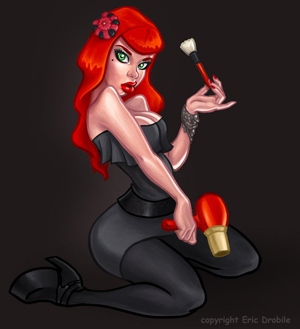
.
One last thing that pertains to your question about the soul of a subject: Study your subject before you begin! Do thumbnails and doodles if this helps you see things, or do it all in your head if you are a very visual person. If it is a portrait, find out what elements of that portrait make it so. What shadows, shapes and colors are ABSOLUTELY necessary to convey the essence of your subject? Now, what elements could be stripped? Get good at making these distinctions, and you will get better at enhancing the important bits and removing the rest. This is a principle I learned in animation and I believe it applies to all art mediums. I think caricature is one of the hardest art forms to master, because it forces you to find what it’s important, enhance it and remove the rest.
.
KARA: Do you start out with overall spacing and color fill, followed by detail?
.
ERIC DROBILE: I think how you get there is inconsequential, so long as you enjoy it. I don’t always use the same techniques or plan to get to a final product because this experimentation is what keeps me interested and learning. That being said I will always start with a rough sketch. I might do two stages of this depending on the difficulty- a really rough version that is basic shapes to plan out composition and staging. Then a slightly more fleshed out version that has some smaller details and shapes. I should say that these steps always look horrendous, and without good reference I find myself having no idea what I am drawing and fudging it. Usually by the third pass, which is the final linework in the case of a comic, it starts looking how it should. I always spend more time on this pass, undoing bad strokes very frequently (the wacom I use is only so accurate) until I get the right one. From there it’s usually filling in color and painting values and lighting, but this is the step that I seem to reinvent every time I do it. If you’re interested, searching for digital painting tutorials on the internet will get you far. I hope to get some of my own tutorials out this year.
.
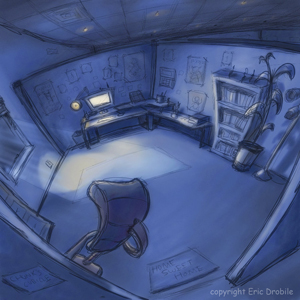
.
KARA: Fantastic. Let us know when! I think your work would really catch the eye of readers if you created art for book covers and promo banners. Have you ever considered painting for commercial publication (for book covers, etc.)?
.
ERIC DROBILE: Absolutely. In the past few months I have started doing commission work more frequently and hope to keep that going. I’ve got some info on my bio page about how to contact me for commissions! http://hatefarm.com/about-eric/
.
KARA: Great. I would like to add that your portraits of Helen are absolutely lovely.
.
ERIC DROBILE: Thanks! It is only because she is so lovely — I have always had such a weakness for drawing beautiful women!
.
KARA: Has the process been a constant move forward or have you experienced moments of inspiration or sudden leaps in improvement with your drawing/paintings? Any event that really sticks in your mind as a transcendent moment?
.
ERIC DROBILE: It has not been a linear slope whatsoever! When I went to college, obviously it spiked, because I was in such an intense creative environment, with a wide variety of classes surrounded by nothing but creative people, but then after that, my drawing life died almost completely. My 3D animation career continued on because I was doing it every day at work. But I had moved in with my girlfriend at the time and we got into some bad habits, partying constantly, coupled with a whole lot of stress and being unproductive. When we broke up, I found myself wanting to get back in touch with drawing and painting, but I was back at the skill level as I was before college. This year has been full of regrowth and new growing pains. I think once you lose it, it comes back quicker, but it still takes a while. You can see the transition very clearly by looking at the first Hatefarm comic and then looking at the more recent ones. I had some very clear “oh shit, I understand how color and lighting works better” moments this year. They are completely random but they feel soooooo good when they occur.
.
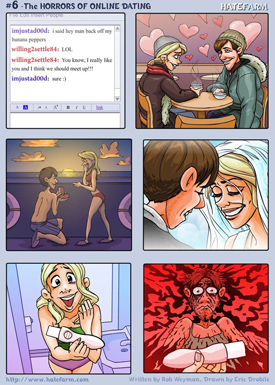
.
KARA: You also have experience with web comics. What do comics give you that you don’t find in creating more traditional art? And I might add ‘traditional’ as just a loosely delegated description because we know comics have been around since at least the Roman Empire!
.
ERIC DROBILE: Comics are great because they can be done fast and you can cover a wide variety of situations, characters, and narratives. I usually spend anywhere from 10-30 hours on a comic, but that is for several panels that tell a little story or joke, where I would spend the same amount of time on a single portrait. Hatefarm was designed specifically for us to have fun with. There are few main characters, so we can do whatever it is we like from comic to comic. This keeps things fresh and is a great forum for exploration. It’s also been a terrific grounds for exploring art styles, comedy styles, also it also lets us act like complete f*ckheads which, while entertaining, isn’t something I think one should practice outside of the internet.
.
KARA: So, Eric, why Hatefarm? How did you come by the name?
.
ERIC DROBILE: Well, originally Rob and I made a list of catchy names for our comic — names that still had the domain name available. They also had to be names nobody else was using — so as you can imagine, the pickin’s were slim. We got all our friends together to vote for the catchiest name on the list, of which I think Hatefarm had the 2nd or 3rd most votes. Personally, I liked the name Hatefarm for a few different reasons…Rob might have a totally separate answer. Hatefarm invokes the kind of backlash any artist gets from putting their work online…and in a way, the word Hatefarm is a synonym for the internet. The internet is full of trolls, people with inferiority complexes that spend their time badmouthing people’s work. Rob and I learned all about this with our first comic, Mall Monkeys. This was back in the high school days, and oh man, people loved it, but there was just as many people that hated it, if not more. And the people who hated it were always more vocal than the people who enjoyed it. That’s a law of the internet, I think. So, to me, it’s like I’m saying, “Hey, we’re going to make a bunch of immature, violent and sexualized comics, and you’re going to hate them. But we’re okay with that.”
.
KARA: Tell me a little bit about how you have developed this art form since your first comic. How much time do you dedicate to it?
.
ERIC DROBILE: Mall Monkeys was a comic that Rob and I (and another guy, Keith) ran from 2001-2004. It was kind of the same format, a few comics a week, where I would do the drawing and those guys helped write comics. In it’s heyday it was about 10 times more popular than Hatefarm is now. It was even more juvenile than Hatefarm is, and I think we learned a few lessons about how far you can go with that. It had some passive racism to it here and there which just isn’t cool. Plus, it was just often stupid for stupid’s sake. I’m not going to lie, I am still trying to find the boundary between smart-stupid and stupid-stupid…but it’s a learning process and I think we’ve come a long way in the year we’ve been around. I hope that this time next year, we’ll actually be funny. I probably devote anywhere from 10-25 hours a week on it. It is kind of a part time job, except I don’t make any money off of it (…yet, I’m hoping).
.
KARA: Your Hatefarm’s Skyrim parody comic was a big hit. Was that a surprise?
.
ERIC DROBILE: No. One thing we learned from the Mall Monkeys days is that doing a gaming comic is the easiest route to comedy, and also website hits. It’s surefire, every time, especially if it is about a new, popular game. I’m not trying to knock creators of gaming comics, because I’m sure it is hard to do it day after day after day and keep it fresh. But it is a proven formula. Mentioning Skyrim, coupled with the fact that I also featured another webcomic artist in that comic, meant I was getting video game fans plus all of his comic readers all at once; it just kind of exploded. I’m not opposed to being a sellout, so long as it’s funny and I’m not doing it constantly. We’re still getting a heck of a lot of readers a day from surfers searching “Skyrim”.
.
KARA: Has this success come with a bit of positive feedback? Notoriety? Backlash?
.
ERIC DROBILE: I think it has been primarily positive. People love their video games. I do too, and I would love to do more video game comics, but I don’t want Hatefarm to become a video game comic.
.
Recently, we have had a female reader chime in that she felt we were degrading the female sex with our comics. This has been absolutely true and in the past few months I have been acutely aware of it. I mean, Hatefarm’s poster girl is a porn star stereotype with no realistic qualities. While I’m not going to turn around and start writing comics strictly for both men and women, I welcome the opportunity to degrade men more in future comics. In fact, that’s what I’m working on right now, a response comic called “A comic for women.” I think everybody needs to be degraded equally.
.
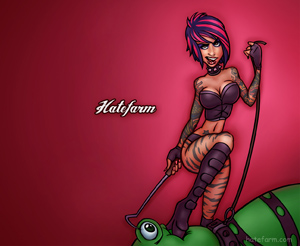
.
KARA: Personally, Hatefarm makes me think of when South Park first came out, how scandalous and hilarious it was. What are your goals with the comic? To instill a sense of irreverence? Shock? Not to take life too seriously?
.
ERIC DROBILE: I think the goal was always to be edgy. Even though I subscribe myself to the idea that nothing is original, the appeal of drawing something really shocking that hasn’t been seen before is a huge motivator. We’re still exploring ideas and finding out what we want to write about, and these days we are responding to fans more. Although for a large part of the year, we just wanted to do what was funny to us. That’s the great thing about the internet, you can go into something having no idea what you are doing, and it will be shaped into purposeful, with time.
.
KARA: I noticed some great references to video games, mad magazine-type foolery, creepy necrophilia and jokes about Elijah Woods. What exactly is your target audience do you think?
.
ERIC DROBILE: We have no freaking clue. I mean, I can look at our Facebook statistics and tell you our target age and gender, but it takes a special kind of person to enjoy our comics. I think, that even our most devout reader is not going to like all of our comics. We’re really just firing our guns in every direction. This goes against the “know your audience” mantra I was taught in school, but I think it can be a strength, and I want people to expect that from us.
.
KARA: Where do you see Hatefarm going in the future? Are you submitting to any contests?
.
ERIC DROBILE: We’ll probably just keep doing our thing as we’ve been doing it. Hopefully the art will get better, the comics funnier, the rare poignant message thrown out to the world, and increased reader feedback and discussion. The interactivity part really gets me going, so I hope that can increase. If I had the time, I might do some short HATEFARM 2D animations. There may be a HATEFARM comic book in the distant future, or really anything that has a whole lot of interest behind it.
.
KARA: Let’s talk about The Animator and the Seat. What a great animation! And you did this in school? Simply brilliant!
.
ERIC DROBILE: Awe shucks, you’re the best, Kara! I did this over the course of a year and a half. Half a year of preproduction (working on story, script, storyboards, concept art and character designs). A year of production from start to finish. It was pretty much my life.
.
KARA: Was it a group endeavor? How did it come to be?
.
ERIC DROBILE: My father composed the music, and the rest (including vocals) was done by me. It was a thesis project at Ringling College of Art and Design that every computer animation student has to go through. It’s really, really, really intense. It was pretty much 12 hour work days for a large portion of that year and a half.
.
KARA: That’s amazing, Eric! Anyone who has worked in the animation industry can completely relate to the idea of a chair taking control of his life, strapping him back into his seat. I love the part where the armrests take on the functions of massaging hands. Do you act out these animations or mostly visualize them in your mind?
.
ERIC DROBILE: For that project, I think I did a lot more acting reference. But I’m not a great actor. I think one of my big animation strengths is my 2D sensibilities, I’ll hop into Adobe Flash and very roughly animate what I want in 2D before I continue. I had a very fleshed out 2D animatic before I started shot production, and that helped, because especially if you are new to 3D, you do not want to be figuring out all the artistic stuff inside of Maya (the animation program we used).
.
KARA: Technically, what was the most difficult part of this animation?
.
ERIC DROBILE: Oh gosh. Well, probably character rigging, which means giving the character functional bones, joints and muscles. It requires a very logical brain to do this kind of stuff, and I do not have that. I got through it with the help of my fellow students and teachers but it was a rough ride. Rigging the chair was the most difficult part, because his hard plastic “legs” had to go from functioning as a regular chair’s legs would, to becoming fully malleable, spider-like walking legs. Not fun!
.
KARA: What was your favorite part?
.
ERIC DROBILE: I think animating Chunk (the main character)’s face was my favorite. I’m really proud of his facial design, it allowed for some great stuff. I also love animating jiggy and overlappy things, so him crying while being massaged roughly, allowed for some hilarious jiggle and goofy expression. I wanted The Animator and the Seat not to be funny Ha-Ha…but awkward funny. I hope I succeeded.
.
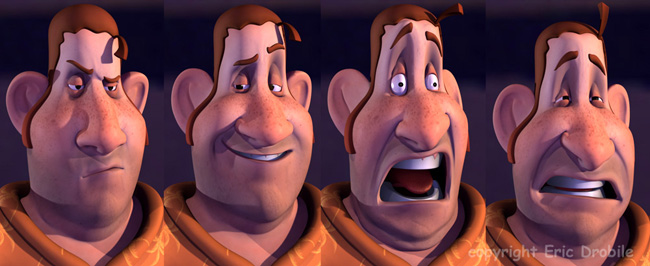
.
KARA: You sure did! Funny about the ‘bears’ comment. A bit of foresight on your part since where you are currently working has had so MANY bear projects (I worked on three myself, lol). Do you like bears? What type of character would be the most fun, biggest challenge to animate?
.
ERIC DROBILE: I put the bear in the short as a way of saying that the animation industry is far too flooded with walking, talking animals. It was kind of a scary coincidence that I would later find myself animating Po from Kung Fu Panda, and being the animation lead for 3 bear characters in Open Season 3. Since then, I have learned to accept that bears are a strange part of my life. I’d say a spirit animal if I believed in that sort of thing. So yeah, I’d say I like them. You can see them frequently appearing in Hatefarm comics now, as well.
.
KARA: I read you had an internship. What was the best lesson you learned from it?
.
ERIC DROBILE: I had an internship at EA games, back when I wasn’t sure if I wanted to get into gaming or film. I loved it there but the gaming industry just wasn’t mature enough to get really good animation into games. I think it’s there now, however. There are a few studios doing FANTASTIC animation work in games, like Naughty Dog, Valve and Blizzard to name a few. My heart is with gaming, and so, I would welcome a return to it some day…but for now, I have a pretty good thing going on in film.
.
KARA: Any other advice you would like to pass on to struggling students?
.
ERIC DROBILE: Take risks, learn to take a critique and don’t let yourself get offended. Set yourself up for failure, and see how well you hold up against the backlash. It will make you stronger. Also, do not allow yourself to be in environments where you aren’t constantly being challenged or challenging yourself. You’ll grow weak! Also take showers, hang out with your significant other from time to time and don’t play too many video games.
.
KARA: Anything else you would like to add for my readers, Eric? Anything to look forward to or a shout out about new material coming from you soon?
.
ERIC DROBILE: Well, tune in to Hatefarm every week or two to see something filthy and probably NSFW!
.
KARA: Eric, thank you so much for stopping by and sharing a little of your artistic magic with us. I adore your explorations of fine art, funny animation, and feisty comics. It’s always a pleasure! Thank you!!
.
ERIC DROBILE: Thank you so much! You are doing the art community a huge service in exposing artists through interviews, it has inspired me and I hope to do the same! I had a blast! Wooh!!!
.
Readers! Thanks for stopping by. Please feel free to leave a comment. It might take me a little while to post them and I appreciate your patience. Hint: the more specific the better. I will know you aren’t an automated spaammbot. Thanks! If you are interested in contacting Eric for commissioned work, check him out. -Kara

One thought on “Artist – Eric Drobile”
Comments are closed.